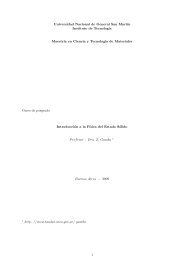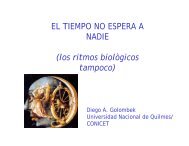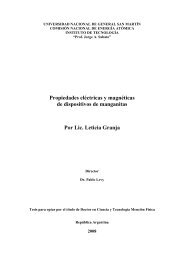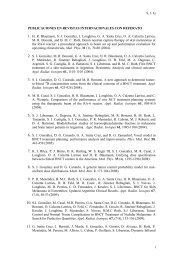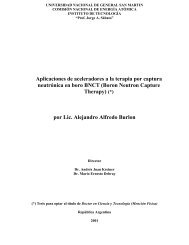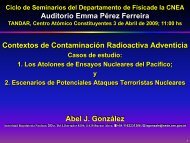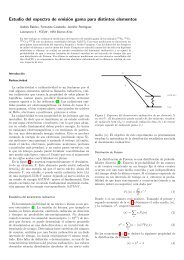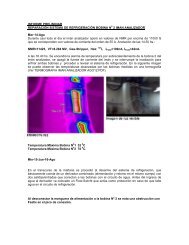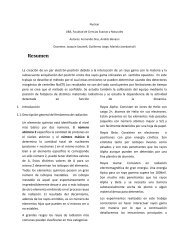Familia de Mapas del Panadero Como Ambiente Caótico de la ...
Familia de Mapas del Panadero Como Ambiente Caótico de la ...
Familia de Mapas del Panadero Como Ambiente Caótico de la ...
You also want an ePaper? Increase the reach of your titles
YUMPU automatically turns print PDFs into web optimized ePapers that Google loves.
CAPÍTULO 1. UNIVERSO CUÁNTICO 15<br />
<strong>Como</strong> habíamos dicho, <strong>la</strong> función <strong>de</strong> Wigner tiene toda <strong>la</strong> información que posee <strong>la</strong> matriz<br />
<strong>de</strong>nsidad. La matriz <strong>de</strong>nsidad se recupera a partir <strong>de</strong> <strong>la</strong> función <strong>de</strong> Wigner y los operadores <strong>de</strong><br />
punto:<br />
ρ = N <br />
W (q, p)A(q, p) (1.30)<br />
(q,p)<br />
En este trabajo utilizaremos <strong>la</strong> tercer propiedad <strong>de</strong> <strong>la</strong>s Wigner para calcu<strong>la</strong>r distribuciones<br />
<strong>de</strong> probabilida<strong>de</strong>s. En espacio discreto, al sumar sobre <strong>la</strong>s fi<strong>la</strong>s (p = cte) o columnas (q = cte),<br />
obtenemos<br />
P (k = k0) =<br />
P (n = n0) =<br />
N−1<br />
<br />
n=0<br />
N−1 <br />
k=0<br />
W (n, k0) (1.31)<br />
W (n0, k) (1.32)<br />
Es posible calcu<strong>la</strong>r W (q, p) analíticamente para un estado posición ρ = |q0〉〈q0|.<br />
1<br />
Wq0 (q, p) =<br />
2N 〈q0|U q RV −p π<br />
i<br />
|q0〉e N qp<br />
= 1<br />
2N δN(q − 2q0)(−1) p(q−2q0)<br />
siendo δN <strong>la</strong> <strong>de</strong>lta discreta periódica <strong>de</strong>finida como δN(q) = 1 N−1 N n=0 ei2πqn/N .<br />
Esto se pue<strong>de</strong> representar en el espacio <strong>de</strong> fases con el siguiente gráfico:<br />
(1.33)<br />
(1.34)<br />
Figura 1.2: Función <strong>de</strong> Wigner <strong>de</strong> un autoestado <strong>de</strong> <strong>la</strong> posición en |n〉 = 8 en un espacio <strong>de</strong> Hilbert <strong>de</strong><br />
dimensión 32. La función es real y toma valores positivos (en rojo) y negativos (en ver<strong>de</strong>).<br />
C<strong>la</strong>ramente, <strong>la</strong>s probabilida<strong>de</strong>s <strong>de</strong> medir q0 = 8 es 1, y <strong>la</strong>s <strong>de</strong> medir q = q0 son nu<strong>la</strong>s. La<br />
línea vertical punteada (en n = 24) proviene <strong>de</strong> <strong>la</strong> interferencia <strong>de</strong> <strong>la</strong> línea positiva (en n = 8)<br />
consigo misma, <strong>de</strong>bido a que el espacio <strong>de</strong> fases es un toro.<br />
En <strong>la</strong> figura se grafican <strong>la</strong>s funciones <strong>de</strong> Wigner <strong>de</strong> dos estados posición. Para <strong>la</strong> mezc<strong>la</strong><br />
estadística sólo aparecen <strong>la</strong>s dos posiciones con sus respectivas interferencias <strong>de</strong>bido al espacio<br />
toroidal. En el caso <strong>de</strong> superposición coherente también hay una línea <strong>de</strong> interferencia localizada



